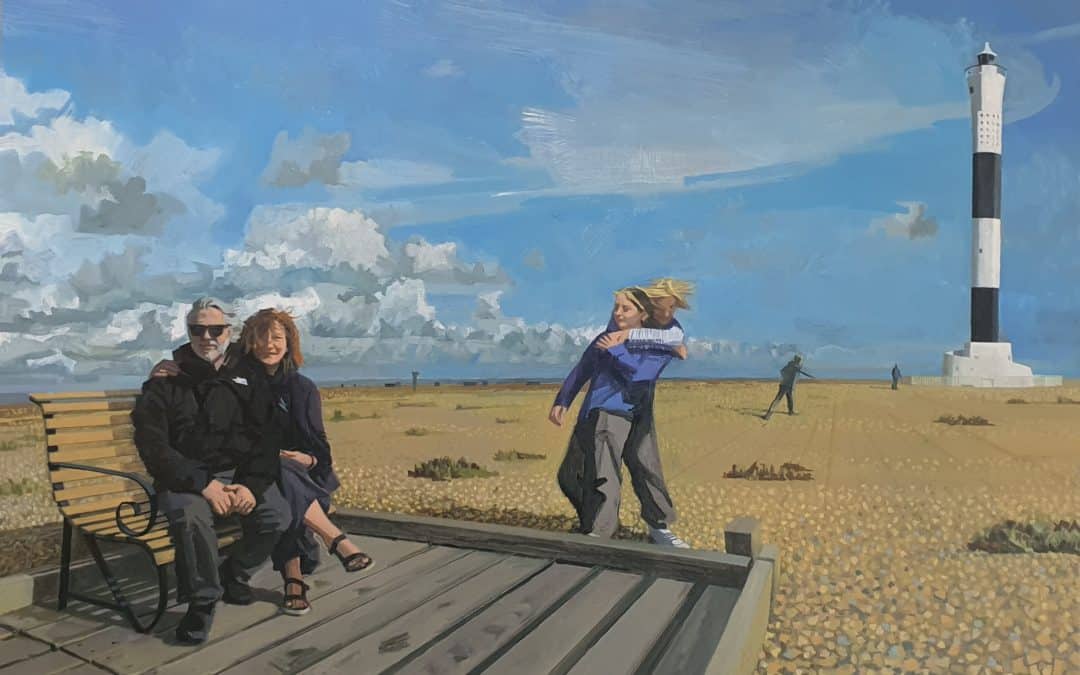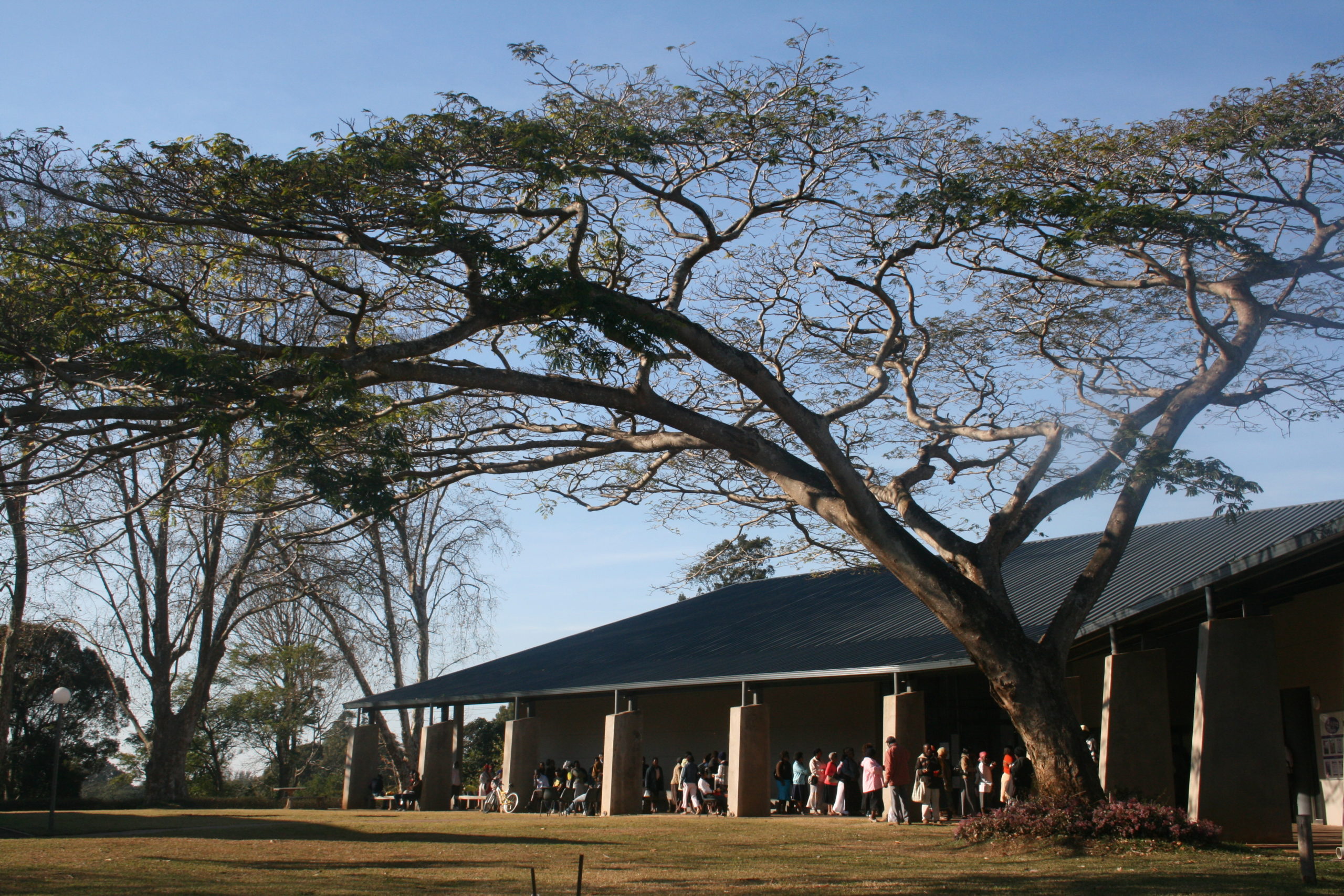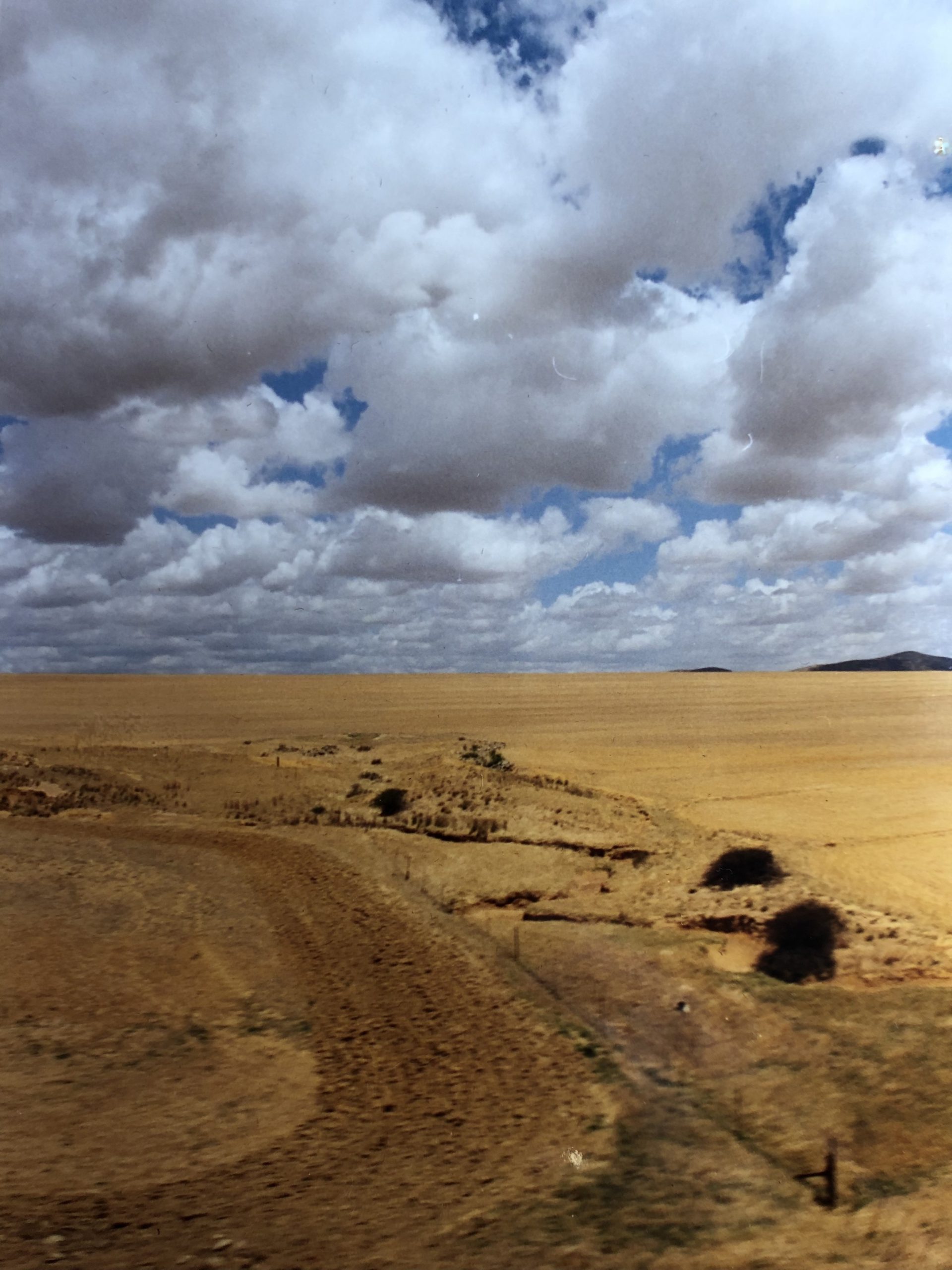‘Just to let you know that your portrait is almost finished. Would you be free for a viewing on Saturday morning?’
My stomach lurched. It was a message from the narrative figurative painter Kate Wilson, who is also my dear friend Katy, on a bright sunny morning in March 2021. If I am honest, the experience of selecting the photographs, choosing the setting and watching the drawings that would culminate in a family portrait had unsettled me. There were so many what ifs – chief of which was, what if people think ‘who does she think she is?’
As if reading my mind, Katy, sent another message: ‘Are you worried you won’t like it?’
Resorting to humour, a well-used defence when someone asks a question that is getting close to the truth, I replied: ‘I’m just worried that I won’t be thin or beautiful enough.’
Katy’s response was, as she often is, witty and truthful: ‘Well, just as well this isn’t a painting about being beautiful or thin. It’s about being alive.’
It seems a lifetime ago now, but as we navigated our way through the early unknowns of the Covid-19 pandemic in 2020, being alive was something to be grateful for.
Before heading over to Katy’s to view the family portrait I had commissioned for a milestone birthday in our household, I took a long, hard look at Four in a Bed. Ten years earlier, after attending an exhibition at Katy’s studio, it was my husband who had commissioned a work of our younger selves and our two children, which now hangs in the bedroom. We both admired her work, which regularly makes it onto the walls of the Royal Academy summer show and has been selected for numerous exhibitions including the National Portrait Gallery Award, Mall Galleries, and most recently, was long-listed for the Contemporary British Painting Prize.
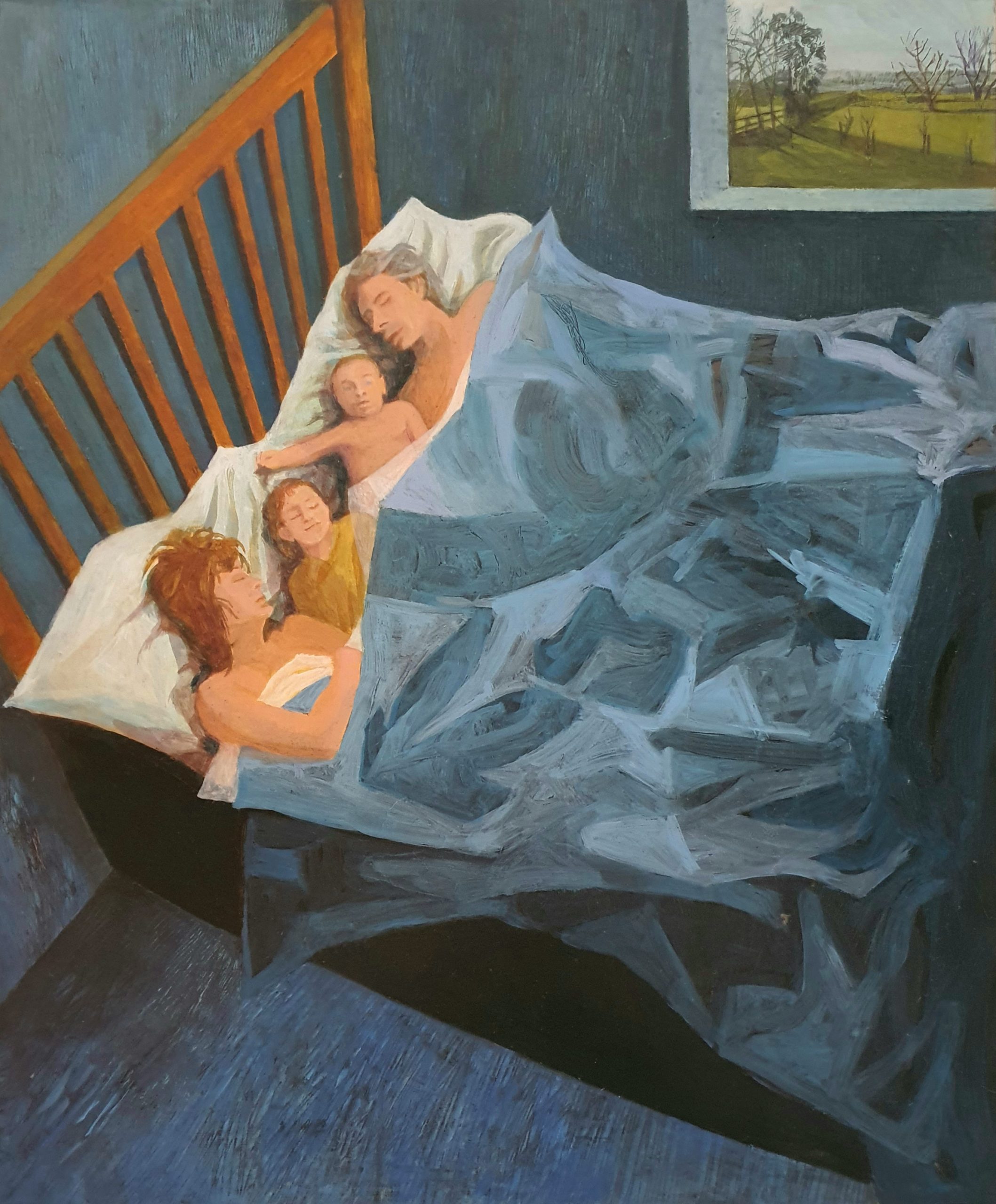
Kate Wilson, Four in a Bed, Oil on Board, 37cm x 44cm, 2010
I have lived with that earlier portrait for more than a decade now. It is the first thing I see every morning and it always evokes a different feeling, depending on my mood. Sometimes I want to go back to that time when we were younger, when the children were small, and life seemed less complicated, but wasn’t. Sometimes I want to fly through the window in the painting into the bucolic green British countryside and lie down on the grass to inhale the summer. At other times, I imagine a landscape where sprawling flat crowns, the magnificent trees indigenous to my home province of South Africa’s Kwa-Zulu Natal, cast shadows across rolling grasslands burnt yellow by the sun. Sometimes, I wonder how I ended up here.
Process, proportions and perspective
This time, however, the commission was mine alone. Over the course of a month, Katy and I went back and forth with WhatsApp messages. I supplied the photographs and she sent back preparatory drawings. They were all beautiful and interesting but something wasn’t right. One Friday, I sensed her exasperation at my insistence that the children’s proportions were wrong. She had sent me a revised drawing of my suggested amends and in it my son, though a good few inches taller than all of us, towers over us like some great Norman hulk. ‘Mmm, well that is obviously completely wrong,’ I replied, to which she responded with a smiley emoji that I read as I told you so!
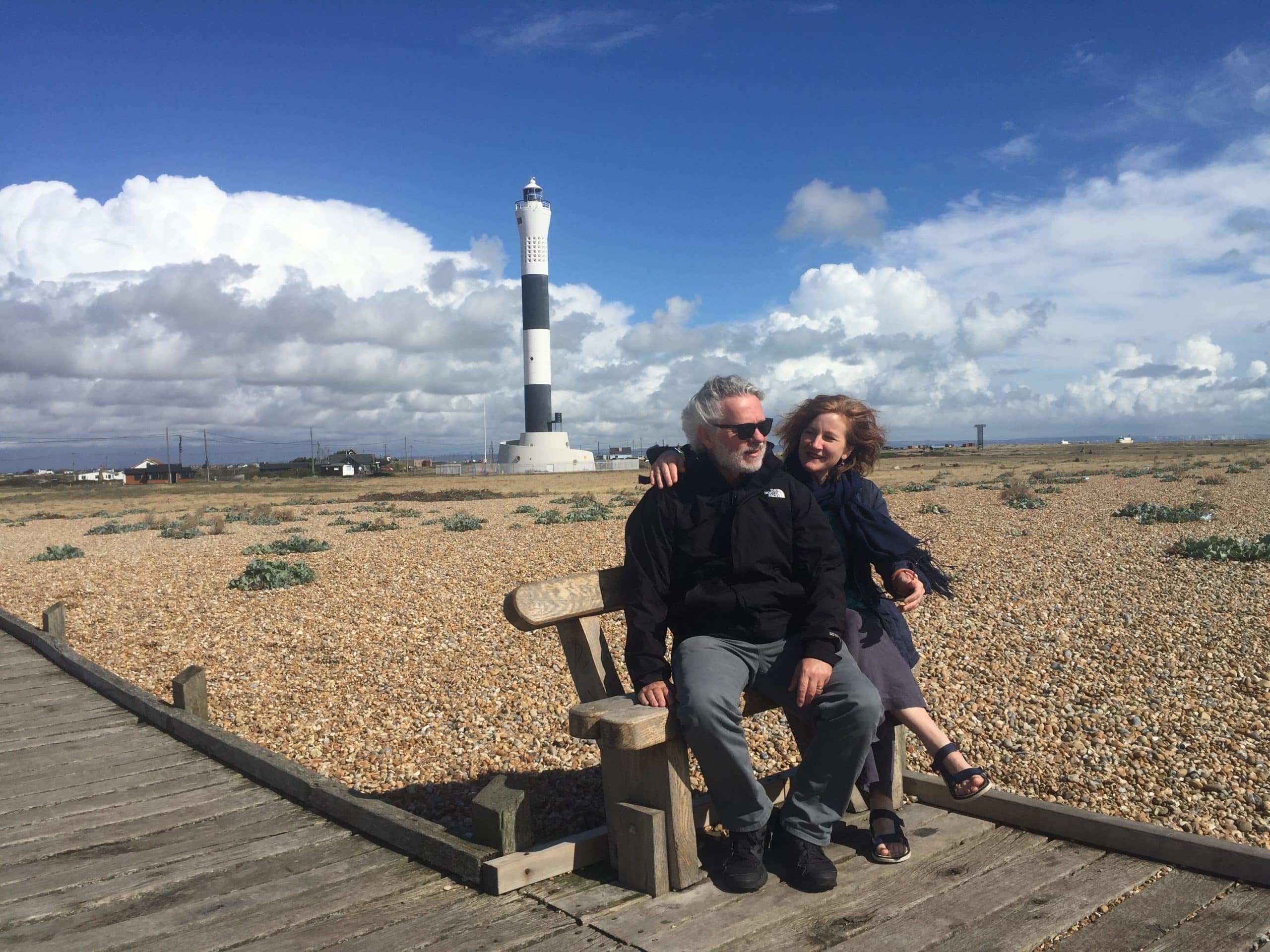
One of the photos from that day at Dungeness
Her last message of the evening suggested that I see the drawings in person. It was the second Covid-19 lockdown, and we agreed to class this as a socially distanced ‘business meeting’. The following morning, as I pored over the sketchpads and cut outs of our various bodies to test different compositions, I felt excited. Seeing the real drawings brought everything to life in a way that no digital image ever could.
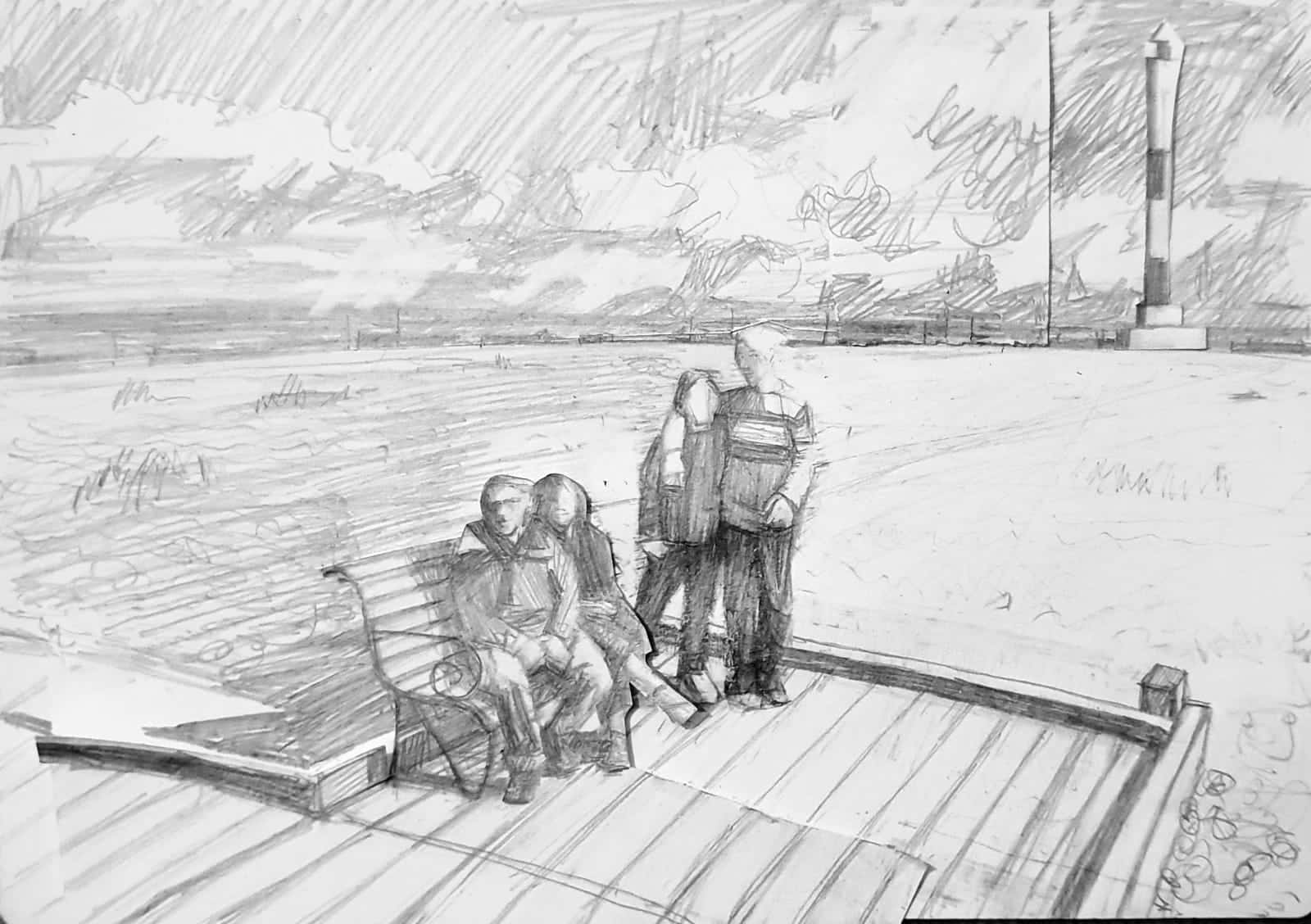
Kate Wilson, Preparatory Drawing
‘What about this,’ I said, pointing to a drawing she had done of one of the photographs that I had supplied of the children on the Ashdown Forest. ‘Yes,’ she said, ‘as teenagers, children are already putting distance between themselves and their parents. Maybe we put them in here on the pebbles to the right, a little bit back from the bench?’
‘Oh, you are clever,’ I said, and really meant it.
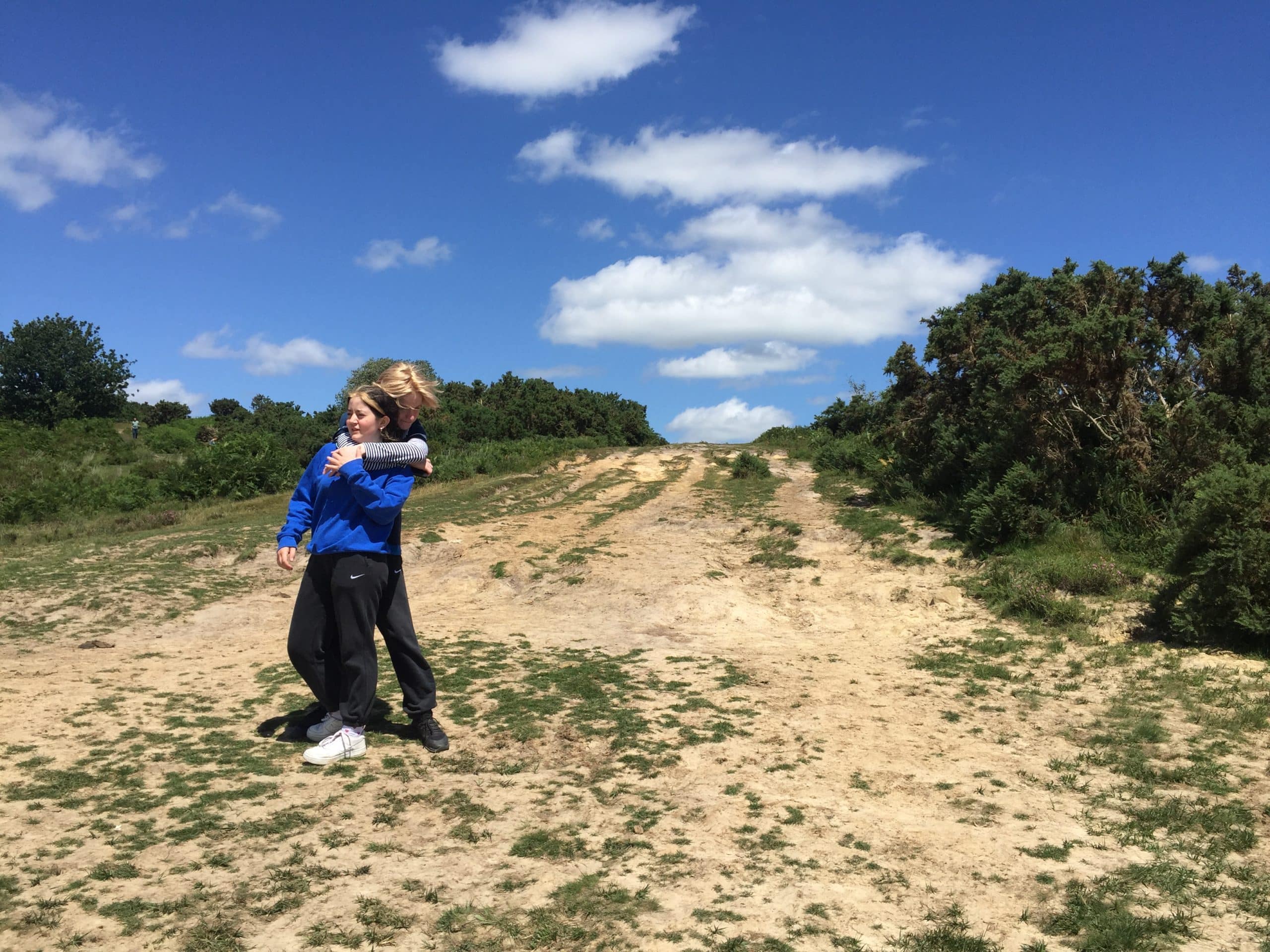
Another of the images – the kids on Ashdown Forest, East Sussex, with Lockdown hair
Katy mocked up the final drawing in the agreed size and the following week she brought it to my house for another business meeting. She held it up against the wall where it might hang. It was perfect but I remained silent.
‘Is there something wrong?’
‘Mmm, no it’s fine. It just that well, you know, commissioning your own portrait feels a bit odd, a bit sort of middle class, a bit who do you think I am?’
‘Aah, I see Pam, well never mind, if people ask, you can always say you wanted to be part of continuing the great British portrait tradition.’ Giving me a short lesson in art history, she flicked through the images on her phone and forwarded a portrait completed in 1750 by Thomas Gainsborough, which now hangs in London’s National Gallery.
‘Look, I think there is a feeling of Mr and Mrs Andrews about your portrait. Except here they are lolling about in front of all their land.’ It made me laugh but the irony did not escape me. I am a journalist and have been working on a novel, a personal project that has kept me busy researching the complex issue of land claims and ownership in southern Africa.
After a bit more philosophical chat about land and who has the right to commission a family portrait, Katy set off back to her studio, leaving me to continue fretting.
Moment of truth
On that crisp spring morning in 2021, Katy welcomed me in. ‘Oh, hello Pam, you go in there and have a look. I’ll make coffee,’ she said. The portrait was on the mantelpiece in the front room.
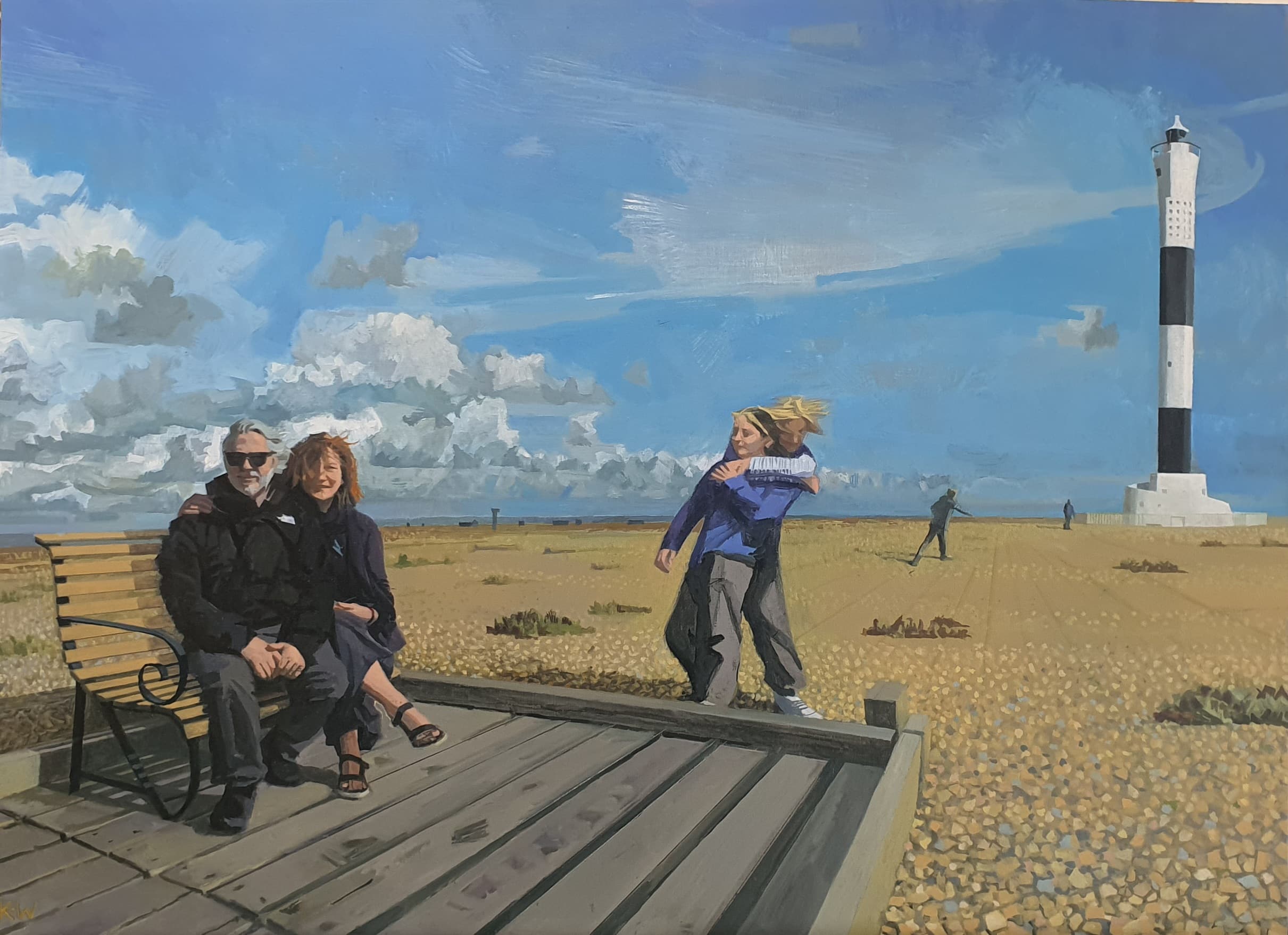
Kate Wilson, Cleggs Unlocked at Dungeness, Oil on Board, 54 x 40 cm, 2021
As I stood there speechless, I recalled my son’s response when I had shown him one of the first preparatory drawings a few weeks earlier. ‘It’s such a stupid idea,’ he had said, ‘why didn’t you just choose a place that we had all been?’
It was true; our then 20-year-old daughter wasn’t with us on that trip to Dungeness, but 2020 was no ordinary year. When I had expressed his concern, and what had become mine, to Katy, however, her response was: ‘Tell him a painting isn’t a photograph. It’s about imagination.’
Imagination. It is exactly that, I thought, as my eyes rested on the children in the foreground and again in the middle distance – two small moving figures who appear to be throwing a frisbee.
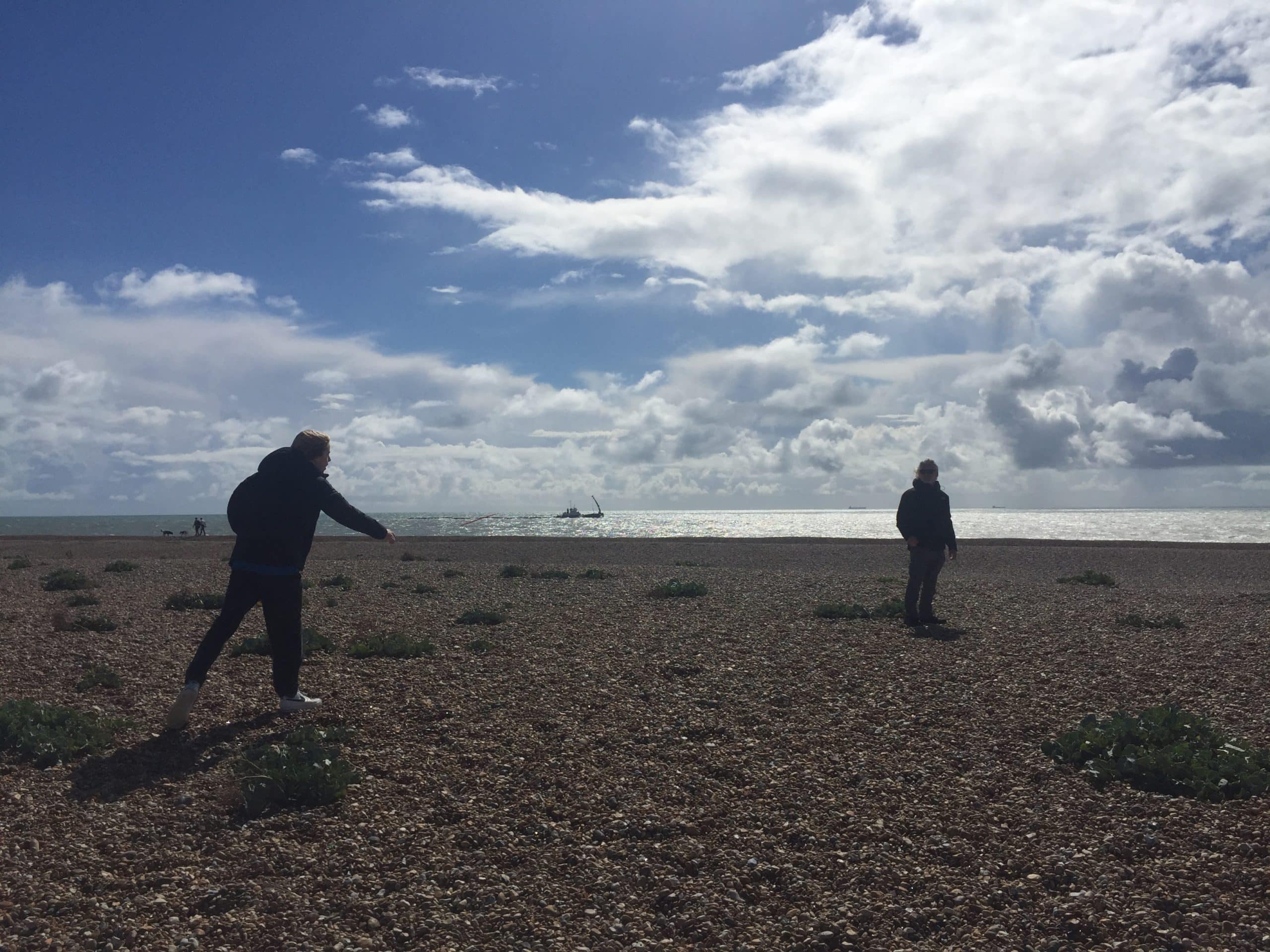
Man and boy: the photo that inspired the children throwing a frisbee
‘Do you like it?’ In that moment of welling emotion, all I could think was that my Mum, who had passed away two month’s earlier in South Africa, would not see it. ‘Well?’ Her question was a little hesitant, a little impatient.
‘Well. Well, I knew it was going to be good but I didn’t expect it to be your best ever portrait,’ I said a few minutes later when I had gathered myself.
We both laughed, and then Katy said: ‘I did enjoy painting it and I am particularly proud of your bench.’
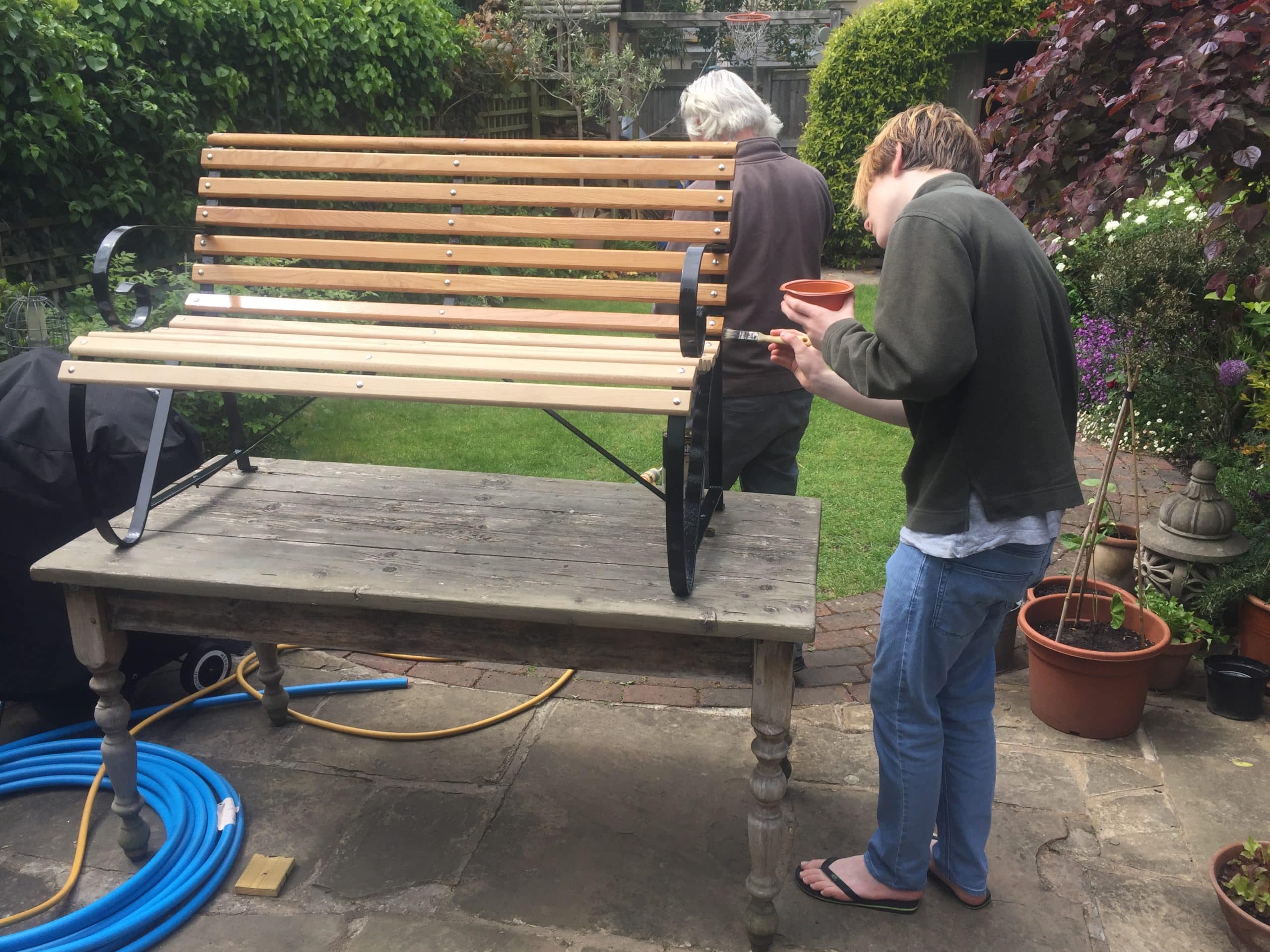
She had reason to be. The exactness of the sensuous curves and wooden slats casting perfect shadows on the boardwalk at Dungeness is a feat of technical drawing. Renovated by my husband and children for my birthday that strange year, the bench feels a bit at odds with the landscape. It should not be there and it is just one of the things that makes the work a little surreal.
Later that day, when I forwarded a photograph of the painting to my brother-in-law, he wrote back: ‘Wow. It’s brilliant in every way. Hockney eat your heart out! Will you sell prints?’
I also sent it to an old friend Koulla Xinisteris, an independent curator and advisor. She too responded with: ‘Wow!!! I want it, I love it! It feels so much like a Hopper painting. It really gets beneath the surface.’ Her words meant something. Koulla has curated the collection of the SABC, South Africa’s national broadcaster, for 25 years, and has been responsible for acquiring some of its most important and valuable works – among them William Kentridge, Dumile Feni and Tracey Rose.
At the official unveiling, two weeks later, there was much studying, silence, and more studying, before my husband, who works on the visual side of the film industry and has an excellent eye, said: ‘It’s beautiful.’ There was more studious silence, and then: ‘It’s a bit British surrealism isn’t it?’ And finally: ‘She has captured a fragment in time. It’s a gift for all of us.‘
Always a painting
Whenever I look at the painting, now framed and hung in our living room, it strikes me that it is the only landscape I could have chosen to have us painted in. It may be tenuous, but there is an echo of the desolate northwestern region of South Africa. On a road trip in the 1990s, my husband and I had spent three nights in basic cottage at the edge of South Africa’s wild Atlantic coast, near Kleinsee, where DeBeers established a diamond mine. At Dungeness they built a nuclear power station. Both are now defunct, both still attract visitors. In South Africa, the mining town, which was handed to Nama Khoi Municipality in 2011, and surrounding area is a pilgrimage on the ‘shipwreck and daisies’ route. At Dungeness, it is a garden, the creation of Derek Jarman, the late British artist and filmmaker who moved there after being diagnosed HIV positive in 1986.
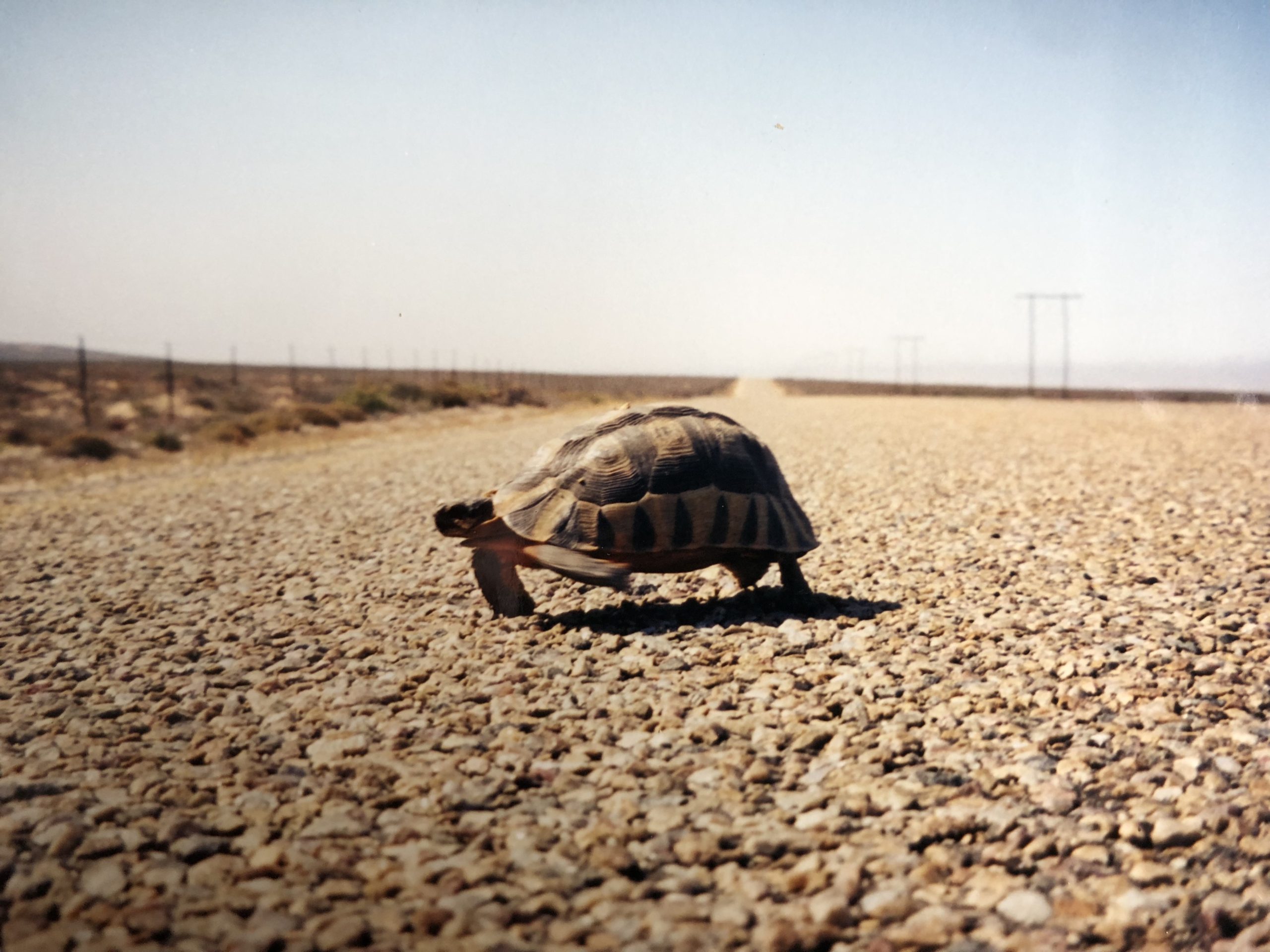
Slow coach on the road to Kleinsee
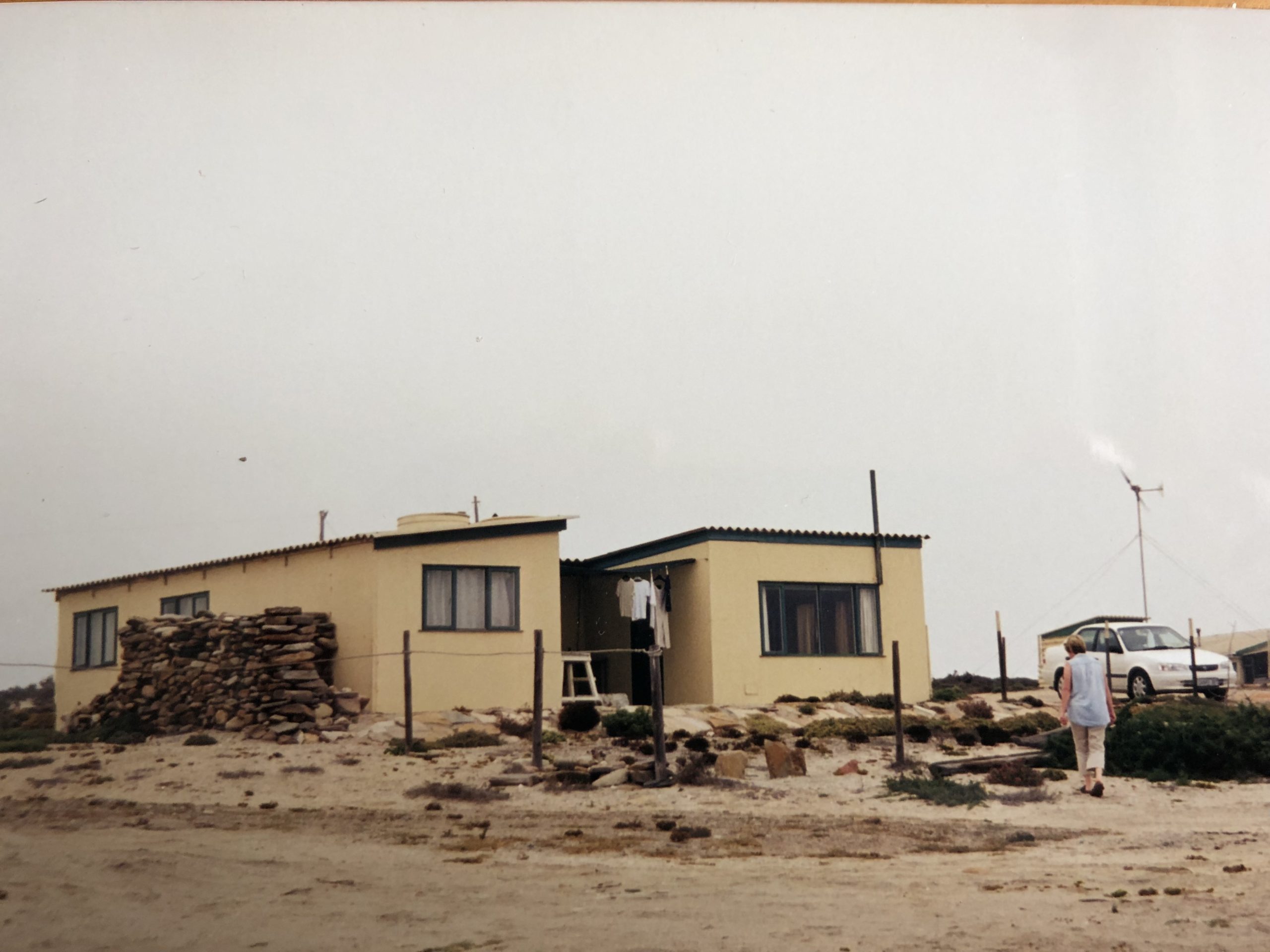
The isolated cottage near Kleinsee in the late 1990s
Like Four in a Bed, there will be years to come when I will look at the painting, and see and feel things that others may not – I will remember the conversation and the violent storm of the previous evening that put those clouds in that shifting sky. It is one of the few places in England that I have ever seen a sky as high and as vast as those you see in Africa.
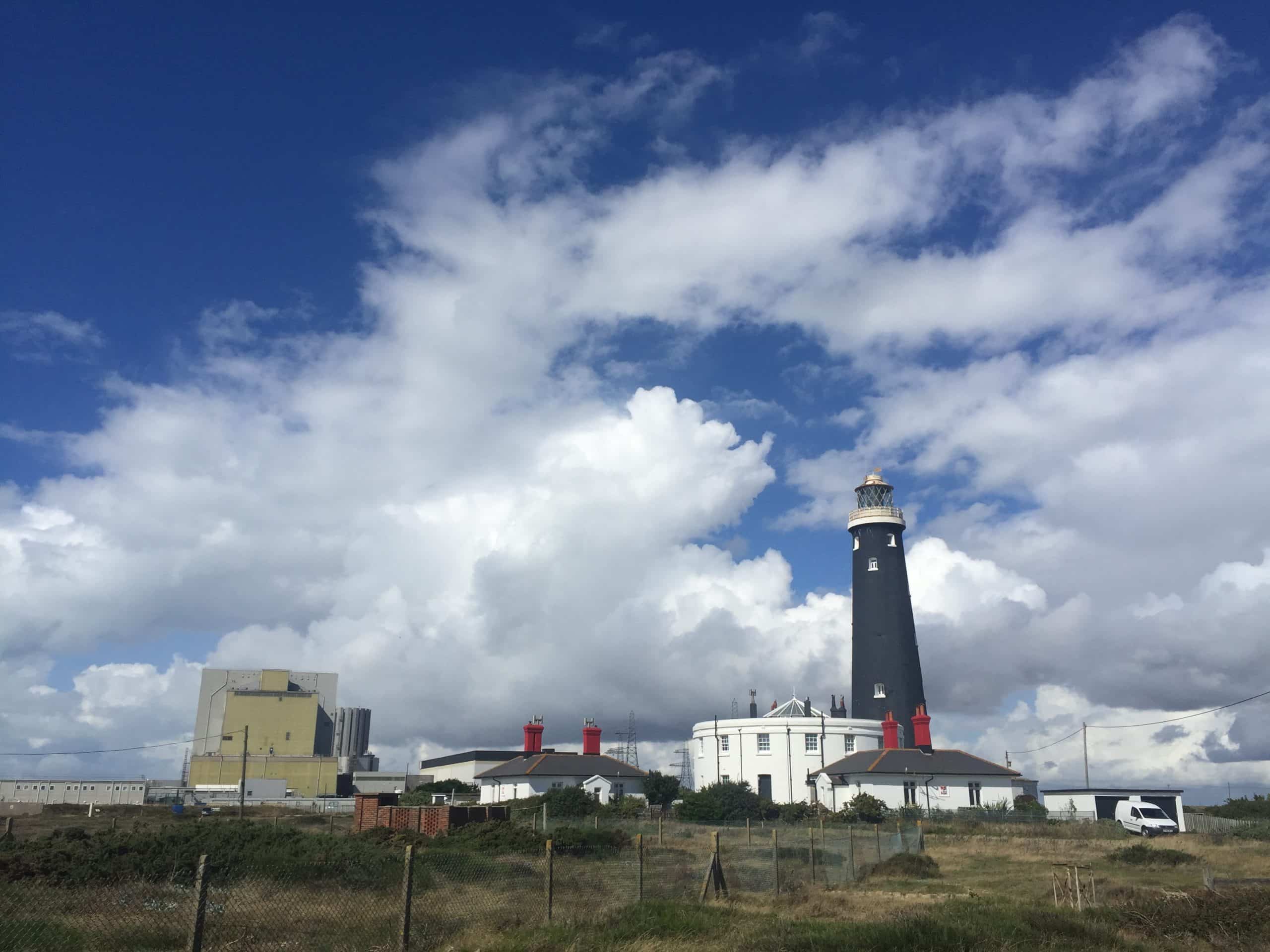
I will see my husband looking silver fox dashing, sitting on our garden bench, the pose, and the hand on a shoulder. I will feel the absence of my daughter that day and the presence of my friend, who was in our Covid-19 bubble, behind the camera.
I will look towards the vanishing point and the lighthouse and wish to walk into that low-lying landscape with its expansive views of pebbles, sea and sky. I will hear the banter of teenagers. I will feel the wind in my hair and the sun on my face. The unseen brutal architecture of the nuclear power station will niggle in the back of my mind.
There will be other things that I remember about that day, that time, in that year of 2020. Maybe one day I will write about it. Maybe I won’t. But there will always be a painting.
